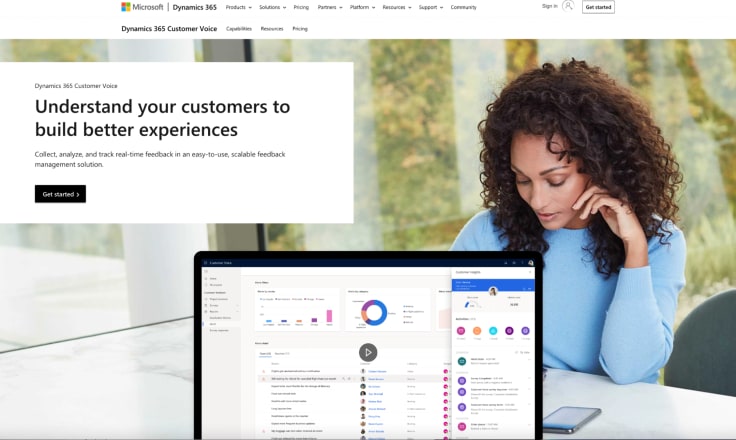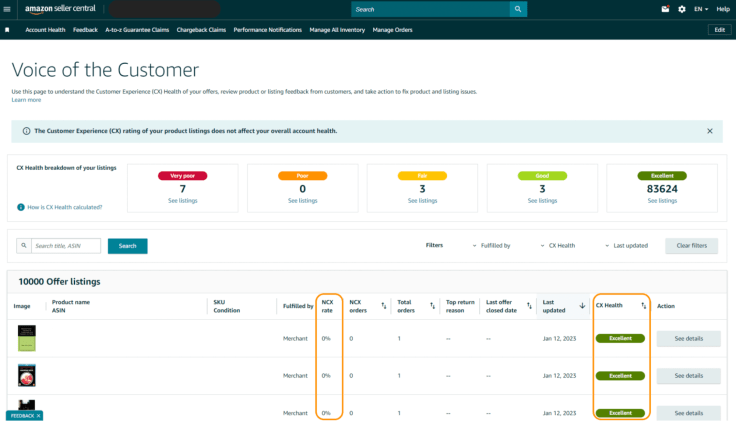Showing top 0 results 0 results found
Showing top 0 results 0 results found

Understanding the voice of the customer has become vital for businesses seeking to deliver exceptional customer experiences. By actively listening to and acting on customer feedback, you can improve customer satisfaction and build strong loyalty.
This article explores the following:
- The significance of the voice of the customer.
- Voice of the customer methods.
- The implementation of customer programs.
- Voice of the customer examples.
- A voice of the customer template.
- The impact of voice of the customer programs on customer loyalty and satisfaction.
What is the voice of the customer?
The voice of the customer (VoC), or voice of customer, is a term used to describe the preferences, needs, opinions, and feedback expressed by customers regarding a product, service, or brand. It represents the collective voice of customers and serves as a valuable source of information for businesses to understand customer expectations and make data-driven decisions.
There are plenty of benefits you can expect from implementing a voice of the customer program. It provides insights into customer experience, satisfaction, pain points, and desired improvements. By actively listening to the voice of the customer, you can identify areas for enhancement, address customer feedback, and deliver better products or services.
Voice of the customer methods
The voice of the customer is gathered through various channels and direct and indirect feedback. To collect and analyze customer feedback effectively, you need multiple methodologies. Check out the most reliable voice of the customer methods:
- Surveys: Design and distribute online surveys to gather structured feedback from customers. Use tools like SurveyMonkey, Google Forms, or Typeform to create surveys with targeted questions about specific aspects of your product, service, or customer experience.
- Interviews and focus groups: Conduct customer interviews or group discussions (either in-person or remotely) to gather in-depth, qualitative feedback. These methods allow for more nuanced insights and the opportunity to probe further into customer opinions and experiences.
- Social media listening: Monitor social media platforms and online communities to capture spontaneous customer feedback, comments, and discussions about your brand or industry. Use social listening tools like Hootsuite or Mention to track brand mentions and sentiment analysis.
- Online reviews and feedback forms: Monitor and analyze customer reviews on platforms like Google Reviews, Yelp, or industry-specific review sites. Additionally, incorporate feedback forms on your website or within your product to gather customer feedback.
- Customer journey mapping: Customer journey mapping is a technique that involves visualizing and understanding the end-to-end customer experience. It helps identify touchpoints, pain points, and opportunities for improvement from the customer's perspective.
- Focus groups: Focus groups involve bringing together a small group of people representing your target audience. A moderator leads a guided discussion to explore specific topics and gather collective insights. Focus groups provide an interactive environment for customers to share their opinions and engage in group discussions.
- Observations and ethnographic research: This methodology involves directly observing customers in their natural environment or using products/services. It helps uncover behaviors, pain points, and challenges that customers may not express through traditional feedback methods.
- Customer support interactions: Review and analyze customer support tickets, emails, and live chat transcripts to identify recurring issues, pain points, or areas for improvement. Find the most popular questions people ask when contacting the customer service team. This data can provide valuable insights into customer satisfaction and areas for enhancement.
- User testing and product analytics: Conduct usability testing sessions to observe how existing customers interact with your product or website and gather real-time customer feedback. Utilize product analytics tools like Google Analytics or Mixpanel to track user behavior, identify usage patterns, and uncover areas for optimization.
- Net promoter score (NPS): NPS is a quantitative measure of customer loyalty and satisfaction. It involves asking customers a single question to gauge their likelihood of recommending the product/service to others. The responses are categorized into promoters, passives, and detractors, providing a high-level indicator of customer sentiment.
Voice of the customer examples
Microsoft
Microsoft has implemented a robust VoC program to understand customer needs and preferences across its wide range of products and services. They collect feedback through multiple channels, such as online forums, customer support interactions, and usability testing, to inform product development and enhance customer experiences.

Zappos
Zappos, an online retailer, strongly emphasizes customer experience and satisfaction. They actively seek and respond to customer feedback, which helps them refine their service offerings, streamline their website experience, and create a memorable customer journey.
Alexander Genov, Head of Marketing Insights and Customer Research at Zappos, explained how they created the voice of the customer program from scratch: “Once we realized that we can bring in more customer data, qualitative and anecdotal, that are powerful enough to design a holistic data program, we built a customer circle and started collecting a lot of feedback.”
They created a program, AI-powered text analytics, to report the VoC and provide insights into what it can do to fix issues that customers were having. The VoC allows Zappos to understand the customer experience better.
“Those hidden insights inform us how likely the customers are to recommend Zappos and how we can improve Zappos,” Genov said. “Now, our executives read customer comments on a weekly basis, then discuss those issues. We have a VoC Top 10 Program where we look at top ten customer frustrations and figure out how to fix those issues.”
According to Genov, every business can create its program. However, it’s essential to focus on the four aspects of data - collecting, storing, analyzing, and acting on customer insights. VoC data alone won’t create customer loyalty. It’s crucial to listen to customers and build trust. That’s why when collecting customer feedback, you need to ensure every piece of it is noticed and heard.
Amazon
Amazon is known for its customer-centric approach and a strong emphasis on gathering and acting upon customer feedback. They regularly collect and analyze customer reviews, ratings, and feedback to improve their product offerings, enhance the customer experience, and drive innovation.
Amazon's Voice of Customer Dashboard is a powerful tool that you can use to collect and analyze customer feedback. The dashboard grants sellers insights into their listings. It can alert about problems that can lead to a drop in a feedback score, negative product reviews, and ultimately, even a suspension of the listings. The dashboard includes a variety of features that make it easy to track customer sentiment, identify trends, and take action to improve the customer experience.

How to build a comprehensive voice of the customer program for your company
To collect feedback consistently and improve customer retention, start by establishing a structured customer program.
Setting clear objectives
Define the objectives of your customer program. Determine the specific insights and feedback you want to collect and how you plan to use customer input to improve your products, services, or customer experiences.
Choosing the right feedback methods
Select appropriate feedback methods (as mentioned above) based on your objectives and target audience. Consider a mix of quantitative and qualitative methodologies to gather comprehensive insights.
Developing a feedback collection plan
Create a structured plan for collecting feedback consistently. Determine the frequency and timing of feedback collection, whether it's ongoing or tied to specific events or touchpoints in the customer journey. Establish clear guidelines for when and how feedback should be collected to ensure consistency.
Implementing feedback collection channels
Set up feedback collection channels such as online surveys, feedback forms on your website, or dedicated email addresses for customer feedback. Ensure these channels are easily accessible and user-friendly for customers to provide their input conveniently.
Personalizing and target feedback requests
Tailor feedback requests to individual customers. Personalize the communication and make it relevant to their recent interactions or experiences with your organization. Target specific customer segments or touchpoints to gather more focused feedback.
Leveraging technology
Utilize customer feedback management tools or customer relationship management (CRM) software to streamline feedback collection, track responses, and manage customer data effectively. These tools can automate feedback requests, provide analytics and reporting capabilities, and help you stay organized.
Training and educating your team
Provide training to your team, especially those who interact directly with customers, on the importance of collecting feedback consistently. Train them on how to ask for feedback, actively listen to customers, and document their insights accurately.
Analyzing and acting on feedback
Regularly analyze the collected feedback to extract meaningful insights. Identify trends, patterns, and areas for improvement. Share the feedback findings with relevant teams within your organization and create action plans to address customer concerns or make enhancements.
Communicating and closing the loop
Close the feedback loop by communicating the outcomes of the customer program to customers. Let them know how their feedback has influenced improvements or changes. This communication fosters transparency, demonstrates that their input is valued, and encourages ongoing participation.
Iterating and improving
Continuously evaluate and refine your customer program based on feedback received and the outcomes achieved. Solicit feedback on the feedback collection process itself to identify areas for improvement and make adjustments as necessary.
Voice of the customer template
Here's an example of a voice of the customer template, including questions that you can ask:
[Your company logo]
Voice of the Customer Template
1. Customer Information:
- Name:
- Email:
- Phone Number:
- Company/Organization:
- Role/Position:
2. Feedback Source:
- Survey
- Inteview
- Focus Group
- Online Review
- Support Interaction
3. Overall Satisfaction:
- Rate your overall satisfaction with our product/service on a scale of 1 to 10:
- What are the primary reasons for your rating?
4. Customer Needs and Expectations:
- What are your main goals or objectives when using our product/service?
- What features or functionalities are most important to you?
- What specific outcomes or results are you looking to achieve?
5. Pain Points and Challenges:
- What are the biggest challenges or frustrations you face when using our product/service?
- Are there any specific areas that you find difficult or confusing?
- Is there anything that prevents you from fully achieving your desired outcomes?
6. Feedback and Suggestions:
- Do you have any specific suggestions or ideas for improving our product/service?
- Are there any additional features or enhancements you would like to see?
- How can we better meet your needs or exceed your expectations?
7. Competitor Comparison:
- Have you used any similar products/services from our competitors?
- How do we compare to our competitors in terms of quality, features, and overall experience?
8. Recommendations and Testimonials:
- Would you recommend our product/service to others? Why or why not?
- Do you have any testimonials or success stories you'd like to share?
9. Additional Comments:
- Is there anything else you would like to add or any other feedback you would like to provide?
Thank you for taking the time to provide us with your valuable feedback. Your insights are greatly appreciated and will help us enhance our offerings to better meet your needs and expectations.
[Contact Information]
- For any additional questions or concerns, please contact:Name:
- Email:
- Phone Number:
Feel free to customize this template based on your specific requirements, industry, and the information you want to collect for customer feedback.
Increase customer loyalty with a voice of the customer program
Voice of the customer has a direct impact on customer experience and loyalty by providing valuable insights into customer preferences, expectations, and pain points.
When you collect customer feedback and improve your product and services, you foster a sense of customer-centricity and demonstrate that your customer opinions are valued. This, in turn, leads to increased customer loyalty.
And is there a better way to run a business than to make your customers happy?
Get a glimpse into the future of business communication with digital natives.
Get the FREE report








Comments